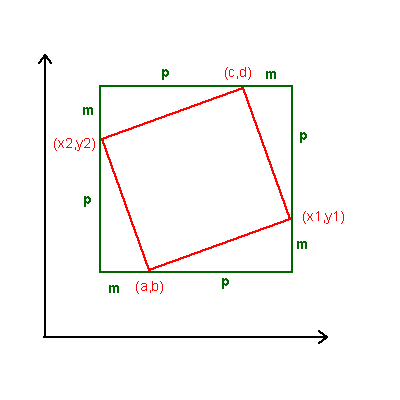Copyright © University of Cambridge. All rights reserved.
'A Tilted Square' printed from https://nrich.maths.org/
Show menu
Much of this solution uses the work of Andrew I and Elizabeth F. Well done.
For the square with opposite vertices of co-ordinates (5, 3) and
(5, 7) respectively, you can obtain the other vertices (7, 5) and
(3, 5) by creating 4 right-angled congruent triangles. The
resulting figure is a square because: it has all its sides
congruent, and all its angles right angles.
For the opposite corners of co-ordinates (5, 3) and (6, 6), using the same method, you get (4, 5) and (7, 4).
Veryfying that the four point sets from the problem are squares:
A. (8, 3); (7, 8); (2, 7); (3, 2) - Yes
B. (3, 3); (7, 4); (8, 8); (4; 7) - No
C. (16, 19); (18; 22); (21, 20); (19, 17) - Yes
D. (4, 20); (21, 19); (20, 2); (3, 3) - Yes
For the general case, using the drawing from the figure.
Let the co-ordinates of one corner be (a, b), and of the opposite be (c, d). Note that (x1, y1) and (x2, y2) are the co-ordinates of the other two corners. The geometrical problem has unique solution, that is obtained in the following manner:

Using the values m and p
| x2 = c - p | (i) |
| y2 = d - m | (ii) |
| x1 = a + p | (iii) |
| y1 = b + m | (iv) |
| c = a +p - m | (v) |
| d = b + p + m | (vi) |
(v) + (vi) gives
c + d = a + b + 2p
p = (c + d - a - b)/2
(v) - (vi) gives
c - d = a - b - 2m
m = (a - b + d - c)/2
Substituting these values for m and p iinto (i), (ii), (iii) and (iv) gives:
x1 = (a + c + d - b)/2
y1 = (a + b + d - c)/2
x2 = (a + b + c - d)/2
y2 = (b + c + d - a)/2